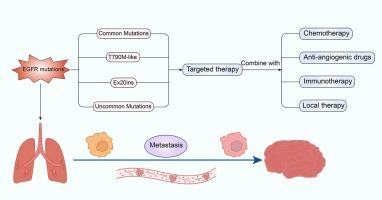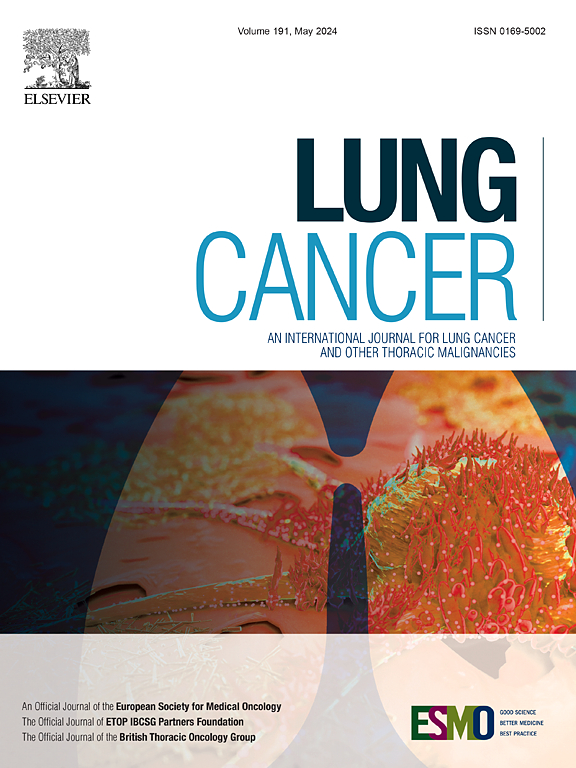Advances in the treatment of brain metastases in EGFR-mutant non-small cell lung cancer
IF 4.4
2区 医学
Q1 ONCOLOGY
引用次数: 0
Abstract
Non-small cell lung cancer (NSCLC) is the predominant subtype of lung cancer, and brain metastasis (BM) is a frequent and serious complication that significantly impacts patients’ survival and quality of life. EGFR mutations play a crucial role in the progression of NSCLC, particularly the Ex19del and L858R mutations. This paper comprehensively explores the pathological mechanisms of BM in EGFR-mutant NSCLC, covering key aspects such as tumor cell invasion, epithelial-mesenchymal transition (EMT), exosome secretion, and blood–brain barrier (BBB) disruption. It also discusses the classification of EGFR mutations and the strategies used in targeted therapy. Notably, third-generation EGFR tyrosine kinase inhibitors (EGFR-TKIs), like osimertinib, have shown remarkable efficacy in treating BM. The paper further explores the potential of combination therapy, immunotherapy, and local treatment options. Despite significant progress, drug resistance mechanisms remain complex. The development of fourth-generation EGFR-TKIs and antibody-drug conjugates (ADCs) offers new solutions to overcome resistance. In addition, dynamic monitoring of circulating tumor DNA (ctDNA) and analysis of cerebrospinal fluid (CSF) can facilitate the early detection of molecular progression and guide precision treatment decisions. In the future, it is essential to optimize combination therapy strategies through multi-disciplinary collaboration, integrating genomics, imaging, and clinical characteristics to enhance efficacy and safety, improve clinical practice, and ultimately elevate patients’ quality of life.

egfr突变的非小细胞肺癌脑转移的治疗进展
非小细胞肺癌(NSCLC)是肺癌的主要亚型,脑转移(BM)是一种常见而严重的并发症,严重影响患者的生存和生活质量。EGFR突变在NSCLC的进展中起着至关重要的作用,尤其是Ex19del和L858R突变。本文从肿瘤细胞侵袭、上皮-间质转化(epithelial-mesenchymal transition, EMT)、外泌体分泌、血脑屏障(blood-brain barrier, BBB)破坏等关键方面全面探讨了脑转移在egfr突变型NSCLC中的病理机制。它还讨论了EGFR突变的分类和用于靶向治疗的策略。值得注意的是,第三代EGFR酪氨酸激酶抑制剂(EGFR- tkis),如奥西替尼,在治疗BM方面显示出显著的疗效。本文进一步探讨了联合治疗、免疫治疗和局部治疗方案的潜力。尽管取得了重大进展,但耐药机制仍然很复杂。第四代EGFR-TKIs和抗体-药物偶联物(adc)的发展为克服耐药性提供了新的解决方案。此外,循环肿瘤DNA (ctDNA)的动态监测和脑脊液(CSF)的分析有助于早期发现分子进展并指导精确的治疗决策。未来,通过多学科合作,整合基因组学、影像学和临床特征,优化联合治疗策略,以提高疗效和安全性,改善临床实践,最终提高患者的生活质量。
本文章由计算机程序翻译,如有差异,请以英文原文为准。
求助全文
约1分钟内获得全文
求助全文
来源期刊

Lung Cancer
医学-呼吸系统
CiteScore
9.40
自引率
3.80%
发文量
407
审稿时长
25 days
期刊介绍:
Lung Cancer is an international publication covering the clinical, translational and basic science of malignancies of the lung and chest region.Original research articles, early reports, review articles, editorials and correspondence covering the prevention, epidemiology and etiology, basic biology, pathology, clinical assessment, surgery, chemotherapy, radiotherapy, combined treatment modalities, other treatment modalities and outcomes of lung cancer are welcome.
 求助内容:
求助内容: 应助结果提醒方式:
应助结果提醒方式:


